Interview with Diana Wyatt
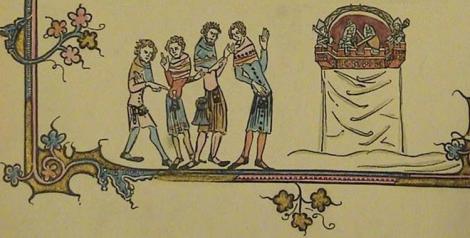
Did you know that a man-eating dragon once visited Durham City? Or that the oldest work of drama in Britain may have been written in the North East? Our exhibition called Plays, Processions and Parchment, which was hosted in Durham Cathedral in April and May 2016, reminded visitors of some of the history of folk traditions, plays, performances and rituals in the North East. One of the curators, Dr Diana Wyatt, gives some of the background.
The exhibition has three ‘Ps’ in its title: Plays, Processions and Parchment. What do these refer to?
The three ‘Ps’ represent the three main aspects of our research and the way it’s reflected in the exhibition.
Plays – such as mystery plays, but also including morality plays, folk plays and even political satires – are a major type of performance we explore.
Processions, traditionally held on religious feast days and involving entire communities, are another. But we also investigate other kinds of performance, from music played by town bands (called waits) to jugglers, dancing bears and even the occasional tight-rope walker!
Parchment refers to the documents where we find our evidence: records designed to last were usually written on durable, good-quality animal skins specially treated for writing on – parchment. Some paper documents have survived, but not so many. The records are of many types: accounts of religious and civic institutions, minutes of meetings, rule books of guilds that produced plays, letters and many more. We try to show images of a range of different types in the exhibition.
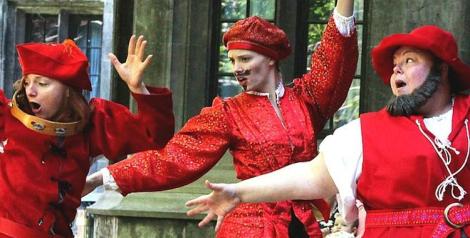
What time period does the exhibition cover?
The period covered is pretty wide. As researchers for Records of Early English Drama, we search for records going back as far as we can find them – which can be as early as the 10th and 11th centuries – up to the ‘crunch’ year for English performance traditions, 1642. That was when, on the outbreak of the English Civil War, all the London public theatres were closed. They didn’t open again till the Restoration of Charles II, 18 years later, and by that time some old traditions had been lost and new ones established.
What’s unique about the North East of England as far as these performances and traditions go?
One of the things we’ve been finding out over the years through research all over the country for Records of Early English Drama is how not only different regions, but even individual towns and cities, had their own unique traditions. So the whole region has rich traditions of folk and religious plays, music and community festivities, and some – such as the famous mystery plays of York and other northern towns – aren’t found in the south of England.
Within the North East, Durham was the only city to elect two Boy Bishops; Ripon possibly had the only dragon in a Rogation Day procession; Beverley had an extraordinarily strong and jealously-guarded position as the regional headquarters for musicians.
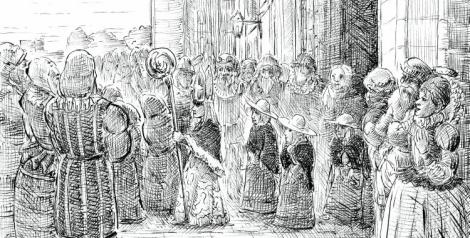
The exhibition is on display in Durham Cathedral. Is there a religious connection with some of the material you’re covering?
Yes, and we’re very grateful to the the Cathedral for permitting us to hold the exhibition there, because much of the material reflects very strongly, much of the material reflects very strongly the importance of drama, music and processions in expressing and nourishing the beliefs and religious traditions of communities. Some of the performances we feature are purely entertainment, and often commercial – the Italian showman who exhibited his fearsome (and fortunately dead) dragon no doubt wanted donations from the public! But many plays and processions, while of course festive and entertaining, were fundamentally celebrations of shared beliefs.
Given that they did not have cameras in the medieval period, how can we know what these plays and performances were like?
We often wish they had had video cameras! Sometimes the written evidence is invaluable in describing customs and performances. We have some records featured in the exhibition that list props and costumes for particular plays, which allow us to gain some insight into how the plays would look. Modern directors then interpret the contemporary visual evidence. The York Baptism play draws on evidence from stained glass windows of how angels were visualised, with feathers all over.
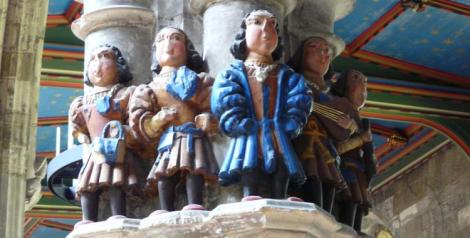
We do have to interpret a lot, because we don’t have any contemporary English drawings or paintings that show plays in production. So we use analogies from stained glass, church wall paintings, book illustrations and so on. Similarly we can use a mixture of written and visual evidence to discover how musicians dressed for performing: records tell us that towns hiring waits would provide them with uniforms, and visual evidence like the wonderful Minstrels’ Pillar in Beverley shows what those uniforms may have looked like.
What’s your favourite case study featured in the exhibition?
I must admit it’s hard to choose a single favourite! But if I can choose a favourite picture and a favourite manuscript, the picture would be one of a gorgeous blue two-wheeled dragon from the Luttrell Psalter, which gives such a wonderful flavour of how stage and processional dragons might have been made. The manuscript would be a York Merchants Adventurers’ document. Still in the keeping of the York Company of Merchant Adventurers since it was drawn up in 1433, it tells us how to design and stage the play of Doomsday in the York Mystery Cycle, and modern directors have drawn on it to learn more about how the play was meant to be staged. It’s amazing that we still have a production brief for a surviving play!
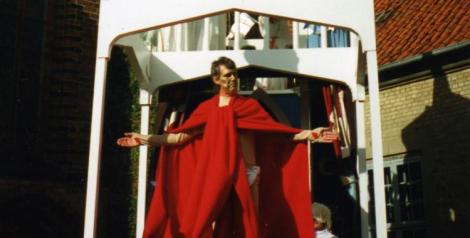
Which play, procession or performance would you like to see resurrected in the North East today?
If it doesn’t seem too morbid, I’d like to see a Dance of Death in action! We have pictures, and there is some slight evidence that it was actually performed, but no details of any performances in this region. I’m looking forward to my first chance to see a Dance of Death recreated this summer when it will be part of the Renaissance spectacle The Sacred and the Profane performed on Palace Green during the Theatrum Mundi play festival.
How can people get involved in the exhibition, beyond visiting?
The most immediate way for smaller visitors is to dress up as a Durham monk or maybe an angel – we’re planning a dressing-up area near the exhibition to give children a chance to be medieval characters.
Apart from that you can tweet us: if you look closely as you go round the exhibition, you’ll see that several panels have questions on them, for example ‘How would you get rid of the Lambton Worm?’ We’d love to have your ideas about that and other questions – tweet us using our hash tag #FestiveNE.
And you can come along to our free weekly 2 o’clock talks on all sorts of topics related to the exhibition – folk plays, music around the region, Corpus Christ celebrations in Durham, comedy in mystery plays, and how Catholic acting companies kept their old traditions alive as they toured the region after the Reformation. The talks will be in the same area as the exhibition, they’ll be short and you can stay and ask us questions and tell us your own ideas. Everyone is welcome, every Thursday throughout the exhibition, starting on 21st April.
